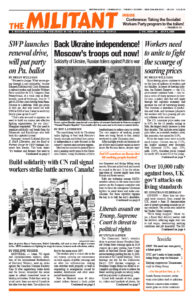Skyrocketing prices continue to batter the lives of millions of workers and our families. In hopes of slowing inflation, the Federal Reserve — the U.S. government’s national bank — has begun a series of sharp increases in interest rates, a policy shift that will ripple through the capitalist economy and increase the cost of borrowing money. This threatens a slowdown in production and trade, and increases prospects that workers will face growing job cuts and inflation at the same time.
The U.S. consumer price index rose to 8.6% for the 12 months ending in May, the largest yearly increase in over four decades. This includes even higher price hikes on essentials workers need, like groceries, that soared by 11.9%.
Prices for many items were actually much higher. Chicken was up 17.4%, the largest increase ever recorded. Pork increased 13.3%; eggs, 32%; milk, 15.9%. Gasoline prices jumped by nearly 50% to over $5 at the pump.
Millions already live paycheck-to-paycheck. The immediate impact of recent price hikes is to tighten the squeeze on workers, making it harder and harder to put food on the table. Real wages declined in May by 3% from last year. Retired workers are finding the value of what little savings they’ve got plummeting. Credit card debt is beginning to grow, and higher interest rates will push that up further.
On June 15 the Federal Reserve announced a 0.75% rise in interest rates on its loans — the biggest increase since 1994. Jay Powell, chairman of the Fed, says more will follow. The European Central Bank announced plans to raise its rates for the first time in 11 years, and promised further raises in July and September.
Working people feel the impact of these rate hikes in many ways, including higher payments on mortgages, auto loans and other debts. The day after the Federal Reserve rate hikes were announced mortgage rates rose to 5.78%, the highest level since 2008, a jump of 85% since the beginning of the year.
“The labor movement needs to fight for a sliding scale of wages — escalator clauses in every contract and all benefits, so whenever prices rise our wages go up automatically,” said Lea Sherman, Socialist Workers Party candidate for U.S. Congress from New Jersey. “And we need a sliding scale of hours — 30 hours work for 40 hours pay — to spread work around as production slows.”
While central banks around the world are raising interest rates, the Bank of Japan plans to keep rates around zero. The country’s currency, the yen, is now worth less in relation to the dollar than any time since 2002. By keeping the yen low, Japan’s capitalist rulers aim to increase exports and gain an edge in the fight for markets. This will bring them into sharper conflict with the Chinese rulers, who depend heavily on exports from China’s industrial base to make profits.
Worldwide surge in prices
Soaring inflation worldwide is rooted in the crisis of the capitalist system, not something that bankers sitting in fancy offices and tinkering with interest rates can resolve. Governments have been printing vast amounts of money — outstripping the output of commodities — to try to help their own country’s bosses compete with rivals. This is what spurs rising prices.
This is exacerbated by Moscow’s assault on Ukraine, and the response of capitalist rulers in Washington and the EU to impose sanctions on Russia. Energy prices rose 39.2% across the eurozone.
“We used to eat beef all the time, now maybe twice a week at best,” pensioner Maria Flier told the Financial Times at a street market in Buenos Aires, Argentina’s capital. Almost all of her savings now go to groceries, she said. Inflation in Argentina is nearly 65%.
In Bogotá, Colombia, potato prices are up by 75%. “Tomatoes have also doubled in price,” Angelica Neira, who runs a vegetable stand in that city, told the Times. “Most things have gone up 100% since the start of the year and if not doubled then they’ve gone up maybe 40% or 50%.”
Rapidly rising prices hit working farmers especially hard, making it difficult for them to meet their costs of production. Diesel prices have gone from about $350 a day to $700-$800 a day, Ty Higgins of the Ohio Farm Bureau told the Dayton Daily News June 12. Fertilizer prices have also risen more than 230%. These conditions will force many farmers deeper into debt and some off the land altogether.
Michael Whitaker, a trucker in Waterloo, Iowa, who hauls construction and industrial machinery around the country told the Investor’s Business Daily that diesel now costs him $4,000 a week.
“As this crisis deepens, bosses will continue putting it on the backs of working people,” SWP candidate Sherman said. “Wherever workers are standing up to their assaults, like the nurses on strike at St. Michael’s Medical Center in Newark, New Jersey, it’s vital our unions extend solidarity to strengthen their fight.”

